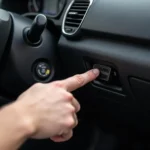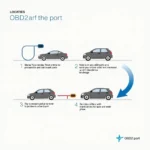The Citroën Berlingo and Peugeot Partner are popular choices for both personal and commercial use, known for their practicality and reliability. Like any vehicle, they come equipped with an OBD2 port for diagnostics. Understanding the Berlingo OBD2 system can be invaluable for owners and mechanics alike, allowing you to quickly identify and address potential issues.
Whether you’re a seasoned mechanic or a Berlingo owner looking to delve into DIY repairs, this comprehensive guide will equip you with everything you need to know about the Berlingo OBD2 system.
What is OBD2 and Why is it Important for Your Berlingo?
OBD2, or On-Board Diagnostics, is a standardized system that allows external devices, called OBD2 scanners, to communicate with your Berlingo’s computer system. This system monitors various components and systems within your vehicle, detecting malfunctions and storing diagnostic trouble codes (DTCs).
By accessing these DTCs with an OBD2 scanner, you can gain valuable insights into the health of your Berlingo. These insights allow you to:
- Identify the root cause of warning lights: The check engine light is often the first indicator of a problem. An OBD2 scanner reveals the specific code triggering the light, providing a clear starting point for diagnosis.
- Diagnose and troubleshoot issues: Instead of relying on guesswork, pinpoint the problematic sensor, module, or system.
- Monitor engine performance: Track vital parameters such as fuel economy, emissions, and sensor readings in real-time.
- Reset warning lights: After addressing the underlying issue, clear the DTC and reset the warning light.
Understanding Berlingo OBD2 Codes
Berlingo OBD2 codes follow a standardized five-digit alphanumeric format. Each code provides a specific indication of the problem area:
- First Character: Indicates the system related to the fault (e.g., “P” for Powertrain, “B” for Body, “C” for Chassis, “U” for Network).
- Second Character: Specifies whether the code is generic (0) or manufacturer-specific (1).
- Third Character: Identifies the specific system or subsystem experiencing the fault (e.g., “1” for Fuel and Air Metering, “2” for Fuel and Air Injection, “3” for Ignition System or Misfire).
- Fourth and Fifth Characters: These two digits pinpoint the specific fault within the identified system.
For instance, the code “P0420” indicates a problem with the catalytic converter system’s efficiency below the required threshold.
Common Berlingo OBD2 Codes
While numerous codes can be triggered in your Berlingo, some are more prevalent than others. Familiarizing yourself with these common codes can be particularly helpful:
- P0420 – Catalyst System Efficiency Below Threshold (Bank 1): This code frequently points to a failing catalytic converter, a crucial component for emission control.
- P0171 – System Too Lean (Bank 1): This code suggests that the engine is running lean, meaning there’s an excessive amount of air compared to fuel in the air-fuel mixture.
- P0300 – Random Misfire Detected: As the name suggests, this code indicates that the engine is experiencing random misfires, often caused by faulty spark plugs, ignition coils, or fuel injectors.
- P0135 – O2 Sensor Heater Circuit Malfunction (Bank 1, Sensor 1): This code indicates an issue with the heating element in the upstream oxygen sensor, crucial for accurate fuel-air mixture adjustments.
It’s crucial to remember that while these are common codes, they don’t provide a definitive diagnosis. Further investigation is always necessary to determine the exact cause and appropriate repair.
Choosing the Right OBD2 Scanner for Your Berlingo
Selecting the appropriate OBD2 scanner for your Berlingo depends on your specific needs and budget. Here’s a breakdown of the common types:
- Basic Code Readers: These entry-level scanners are the most affordable and can read and clear basic engine-related DTCs. Ideal for DIY enthusiasts looking to understand and address simple issues.
- Advanced Code Readers: These scanners offer more features than basic code readers, including the ability to view live data, freeze frame data, and access manufacturer-specific codes. They provide a more comprehensive diagnostic experience.
- Professional OBD2 Scanners: These high-end scanners offer the most advanced features, including bi-directional control, allowing you to perform various tests and functions. Typically used by professional mechanics.
Tips for Using Your Berlingo OBD2 Scanner
Using an OBD2 scanner might seem daunting, but it’s fairly straightforward. Here are some helpful tips:
- Locate your Berlingo’s OBD2 port: Typically, it’s located under the dashboard on the driver’s side.
- Plug in the OBD2 scanner: Ensure your vehicle’s ignition is turned off before plugging in the scanner to avoid any potential electrical issues.
- Turn on the ignition: Turn the key to the “on” position but don’t start the engine.
- Follow the on-screen prompts: Each scanner is different, so follow the instructions on your specific device to read, clear codes, or access other features.
Conclusion
The OBD2 system in your Berlingo is a powerful tool that empowers you to understand and address potential issues. By understanding how to leverage this system and choosing the right OBD2 scanner, you can diagnose problems accurately, save on costly repairs, and keep your Berlingo running smoothly for years to come.
Remember, while this guide provides a comprehensive overview, seeking professional help is always recommended for complex issues or if you’re unsure about tackling a repair yourself.


